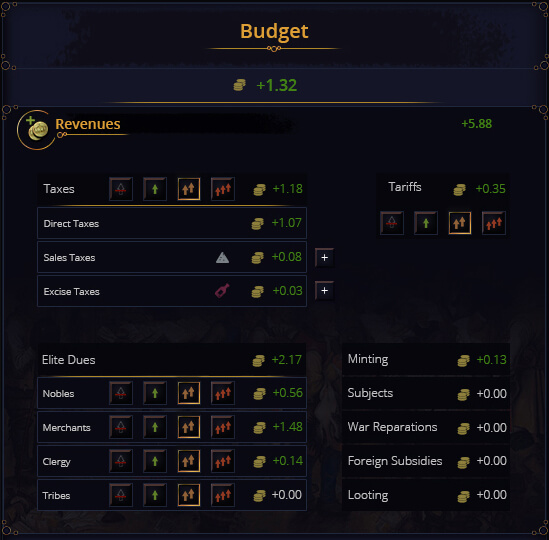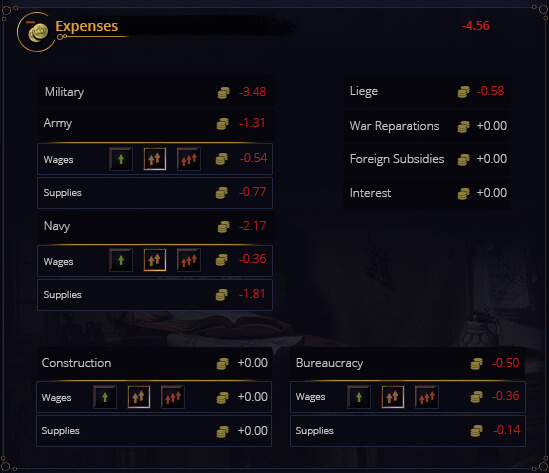Dev Diary #15: Budget
16:43, 1 Oct 2022

Hello and welcome to the 15th development diary of Grey Eminence!
We’re continuing the series of dev diaries dedicated to the economy today by looking at the budget. Unlike the two systems we covered previously (production and consumption), the budget is a system that you’ll have to interact with quite frequently through every run if you want to be successful. Funding your country’s various expenditures is of crucial importance and it can also have significant consequences depending on just how far you’re willing to go in extracting wealth from the different layers of society.
We’ve designed the budget to be the central location where you can see all the revenues and expenses of your country at a glance, with a detailed breakdown of what each item consists of and what it does. You also get the opportunity to configure most items to suit your current budgetary needs (with varying effects we’ll describe in a moment).
Revenues
Running a country takes money, and that money (usually) has to come from somewhere. There are various sources of revenue through which a country might fund itself, so let’s start with a breakdown of the major ones.
As the saying goes, “Nothing is certain except death and taxes”. This applies as much to the real world as it does to Grey Eminence, where taxation is the cornerstone of revenues for most states throughout the game’s timeframe. We’ll go into greater detail on the various types and flavors of taxation later on in the dev diary dedicated to taxation, but for now we can give you a breakdown of the three main tax categories: direct taxes, consumption taxes, and excise taxes.
Direct taxes are the primary taxes your country collects from its entire populace. Their exact nature depends on your country’s tax laws: they might take the form of a poll tax or an income tax, for example. Unlike direct taxes, which are levied directly on the population, consumption & excise taxes are levied on transactions (consumption for consumption taxes & production for excise taxes). They allow you to target specific parts of the economy for raising revenue, allowing for more precise intervention. For example, if your country has a strong domestic alcohol industry, an alcohol excise might raise quite a fair chunk of money without placing an undue burden on the general population.
Like most other sources of revenue, the level of taxation in your country can be configured. This affects all three types of taxes (if you have any consumption and excise taxes active, of course, as they’re optional). There are four levels from which you can choose: none, low, medium and high. Any level of taxation beyond none will generate a certain level of discontent, which can eventually lead to rebellions and revolutions (though just high taxes alone are usually insufficient to cause an uprising).
Another major source of revenue for your country are the elites. As we’ve discussed previously, every country has various power holders - the nobility, clergy and merchants - whose internal machinations can greatly bolster or hinder your efforts. They can own vast estates and might even be wealthier than their host country, but luckily, they can also be subject to taxation in the form of dues. This acts as an income tax on their income (not revenue!) from all the buildings they own. The dues for each elite type can be configured separately, but they apply equally to all members of that elite. Like regular taxation, there are four levels here (none, low, medium, high), with any level beyond none generating increasing amounts of favors for those elite characters - which they will then try to use to force concessions from you.
A third revenue source is tariffs. We won’t go into too much detail here - you’ll have to wait for the dev diaries on trade to learn the full details - but in short, whenever your country imports or exports goods, a fee can be imposed. This has the dual purpose of raising revenue for the country & impacting the profitability of the tariffed trade routes, which can result in alternative routes emerging. Tariffs too can be configured along the usual four levels we’ve shown so far.
One final revenue source we’ll mention is minting. It’s the only source of revenue that truly appears out of nothing, representing the minting of new coins (or printing of new notes). Minting is closely tied to the game’s inflation mechanic, which will also be getting its own dev diary later down the line, so stay tuned for more details.

The Free City of Hamburg is a modest polity, comprising just a single tile in the northern part of the Holy Roman Empire. Being small does have its benefits though: the Hamburg government is able to extract a much larger proportion of revenue from its people compared to the larger medieval realms of Europe.
Expenses
The reason a country levies taxes and brings in revenues is to pay for its expenses. These are the functions that justify the state’s existence and through which you, the player, can exert influence over the rest of the game. Expenses can either be mandatory or optional and vary greatly depending on your country’s laws and technologies. The core expenses of every country are its military, bureaucracy, and construction.
Maintaining a strong military is of the utmost importance to most countries, as that’s usually the only thing preventing other countries from conquering them. Unfortunately, armies (and especially navies) aren’t cheap. They consume a lot of goods and don’t generate any revenue directly - except via looting, but that’s a different topic - yet they’re an unavoidable expense under most circumstances, so most countries will have to come to terms with the fact that the majority of their budget will be going towards the military.
While cutting back on goods isn’t possible, cutting military wages is. Unfortunately, their wages cannot be zero, so unlike revenues there are only 3 levels here: low, medium and high. Cutting wages will obviously have a negative impact on morale (more on that in the dev diaries on war), but it will also make the burden of military costs slightly more bearable.
Another mandatory expense for (almost) all states is the bureaucracy. It’s the embodiment of the state, through which all its other functions are exercised, so keeping it well funded is a good idea. Luckily, most countries during the first half of the game can get away with maintaining a very small bureaucracy, since their countries are decentralized and autonomous (with elites filling this power vacuum), so bureaucratic expenses tend to be much smaller compared to military ones at first. Here too you can modify wages along the 3 levels we mentioned previously, with this having a strong impact on corruption, but for the full details you’ll have to wait for the bureaucracy dev diary.
The last expense type we’ll mention today is construction. Unless you plan on leaving your economy on autopilot (a.k.a. in the hands of the elites) - which, to be clear, is a perfectly viable option in line with our optional complexity game design - you’ll eventually want to construct new buildings (or to expand existing ones). This means paying for construction materials - including the logistics of getting them to the target tile if they’re not available locally - and paying the wages of the construction workers. Modifying their wages affects construction speed, so you can decide whether time or money is more valuable to you.

Hamburg’s small size makes its bureaucracy very efficient and cheap, allowing the state to maintain a respectable fleet - a very useful tool for a city-state that’s entirely reliant on seaborne trade.
Moddability
As one of the primary levers for player interaction, the budget system has been designed to be as moddable as possible. The good news is that we’ve been able to avoid hardcoding mechanics here, so you can link various parts of the economy (or other systems, like diplomacy, war & demographics) to the budget relatively easily. You can also add more levels for each setting if you prefer having more granularity and you can add new settings altogether - for example, separating the taxation levels for each tax type. Of course, you can also add various effects to each tax level beyond those we’ve added ourselves.
That’s all for now, thank you for reading! We’re happy to say that we’ve been able to maintain our development pace for two months now, so we can confidently say that the trough is behind us. We’re now optimistic that we’ll be able to start bringing the pace of development back towards full time early next year. Stay tuned for the next dev diary on November 5 and don’t forget to join our Discord and Subreddit, and to follow us on YouTube, Facebook, and Twitter.


 Back
Back